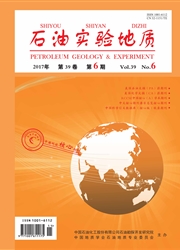

 中文摘要:
中文摘要:
依据地震、测井、钻井岩心、地球化学等资料,对济阳坳陷古近系孔店组层序界面进行了系统研究。济阳坳陷古近系孔店组层序界面在地震剖面上表现为上超、下超、削蚀、顶超、整一等反射特征;钻井岩心表现为风化壳和岩性岩相转化特征;岩电关系表现为不同类型的岩电突变;地球化学微量元素也表现为突变特征。识别出4个层序界面,分别为一级层序界面TSB1,二级层序界面SSB1,三级层序界面SB1和SB2。 TSB1层序界面主要为区域性质的不整合面,反映了盆地的转化形成;SSB1层序界面主要为构造幕式转化面,反映了盆地断陷作用的阶段变化;SB1和SB2为气候转化面,反映了气候因素引起的旋回变化。层序界面对盆地形成机制、气候变化、幕式断裂活动等具有指示意义。
 英文摘要:
英文摘要:
Based on seismic, logging, drilling cores and geochemical data, the sequence boundaries of the Kongdian Formation of Paleogene in the Jiyang Depression were systematically studied. On seismic profiles, the boundaries were featured by onlap, downlap, truncation, toplap and concordance. The drilling cores showed weathering crust and lithology-lithofacies transformation characteristics. The rock-electricity relation indicated different types of mutations. The trace elements also showed mutation characteristics. Four sequence boundaries were identified, including the 1st-order sequence interface TSB1, the 2nd-order sequence interface SSB1 and the 3rd-order sequence interfaces SB1 and SB2. As regional unconformity, the sequence interface TSB1 reflected ba-sin transformation. The sequence interface SSB1 was constructed ceremony conversion surface and showed basin rift stage. The sequence interfaces SB1 and SB2 were climate transformation surfaces and showed the cyclic chan-ges in climate factors. The sequence boundaries were significant for the studies of basin formation, climate change and screen fracture activity.
 同期刊论文项目
同期刊论文项目
 同项目期刊论文
同项目期刊论文
 期刊信息
期刊信息
